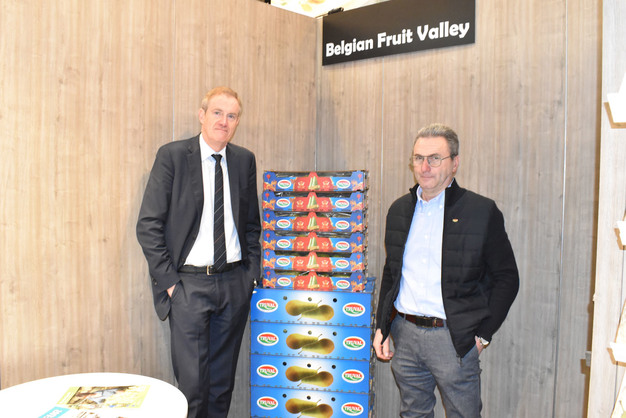"We're genuinely highly optimistic, given consumer reactions on the far side of the world," begins Marc Evrard, Belgian Fruit Valley's Commercial Director. He is referring to the top Belgian fruit exports under the Truval brand name to distant destinations like India and Southeast Asia, including China. "There's increased demand and growth potential."
 Marc Evrard (Belgian Fruit Valley) en Patrick Thoen (BelOrta)
Marc Evrard (Belgian Fruit Valley) en Patrick Thoen (BelOrta)
Marc also sees potential in markets such as Japan, South Korea, and the Philippines that were, thus far, closed to Belgian top fruit. He, nevertheless, remains on his guard. "We have to get things squared away," Marc says, referring to the many international trade and logistics disruptions that sometimes make exports unpredictable.
Ten days longer is no problem
Logistics disruptions in the Red Sea add about ten days to a product's journey to, say, China, but that need not be an issue, Marc points out. "That's doable with properly selected and refrigerated fruit. It usually takes 30 to 40 days for pears to reach China, and once there, they can be stored locally in good refrigeration for another month." He considers the unpredictability caused by irregularities, which affect delivery times, a bigger problem.
"At one point, ships already in the Red Sea had to make an about turn to sail around the Cape of Good Hope. Those arrived at the same time as ships that sailed directly around the Cape from Antwerp or Rotterdam some ten days later. That resulted in some irregular deliveries. That means one week no product arrives and two weeks later, for example, slightly too much. For us, it's vital to follow up the just-in-time deliveries as well as possible so retailers on the other side of the world can also get their orders," says Marc.
Market dynamics
Conference pears' current good prices also affect market dynamics, he notes. "The European pear production is small, so the market is good. Your growing company doesn't necessarily have to cultivate much to get profitable results." Nevertheless, Evrard sees there is plenty of export product available.
That dynamic has another side: more export products are being offered from other countries of origin. "If local pears are priced at about 50 euro cents, it's much harder for competitors, with all the transportation costs, to go below that and still earn something. When prices top a euro, it's easier for, for instance, Spanish producers to sell a cell of pears for 90 euro cents," Marc explains.
Exports from other places
That leads to South Africa and Argentina sending far more pears to Europe. "That's partly because it's becoming more interesting for them to sell to Europe. At low prices, the Argentines make no profit when sending pears here. But they can when prices reach a euro."
Marc admits that the impact of this influx of other pears is yet to be determined. "That will become clear in the coming weeks and months, when a mass of product, for example, other pears varieties from Argentina will arrive," he says. Still, Marc does not expect foreign pears to outdo the Belgian ones, if only because some retailers prefer Conference pears' flavor and unique characteristics. Flexibility, too, counts in Belgian Conference pears' favor. "If we get an order from, say, Munich for a load of pears in the morning, we can deliver them that same afternoon or the next morning. That's not so easy with a shipload of Argentinian pears."
Moving in the wrong direction
Marc points out that the elimination of a growing number of crop protection packages is a challenge that is starting to affect the top fruit-growing market. Grower and BelOrta director Patrick Thoen agrees that the reduction of these packages is causing problems, sometimes even leading to products becoming unmarketable.
Marc cites the brown marmorated stink bug that has taken hold in Italy as an example. "There are no more means to control that insect. So you can't sell the fruit coming off the trees or do anything about it anymore. You used to have a toolbox with something against all diseases and organisms. Nowadays, that is starting to get empty, ultimately a serious challenge. And that affects trade, whether you sell to Belgian, German, or Chinese stores," he explains.
The future
Patrick and Marc, nonetheless, see a future for Conference pear cultivation in Belgium as well as its export. "Our region is a roughly 100 km long and wide corridor that is best suited, globally, to grow these pears. Other European areas are too hot in summer and/or too cold in winter," Marc reckons.
He considers that costs rising in Southern Europe and Poland, too, another advantage. "That's significantly shrunk the cost difference with those in Belgium, while productivity here is much higher." The commercial director points out that Southern European pear growers get 15 to 20 tons of pears from a hectare in a regular season. His Belgian colleague produces at least double that and even more. "It costs about the same but results in a quality pear with good flavor, sugar content, and firmness," Marc concludes.
Marc Evrard
Marc.Evrard@bfv.be
Patrick Thoen
Thoenfruit@outlook.be \
![]() BelOrta - Belgian Fruit Valley
BelOrta - Belgian Fruit Valley
Mechelsesteenweg 120
B-2860 Sint-Katelijne-Waver, België
Tel.: +32 (0)15 55 11 11
info@belorta.be
www.belorta.be
www.belorta.be
